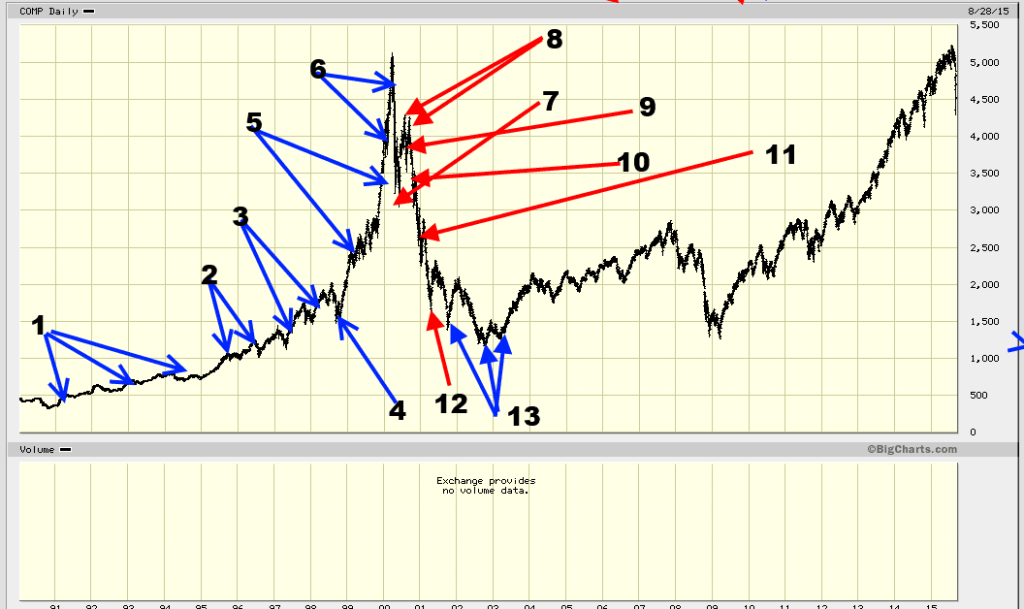Decoding Success: Strategies to Win the Stock Market Game
Updated April 26, 2024
The early bird gets the worm; the late bird the bullet. Sol Palha
We covered this topic several years ago but used a chart of the now-defunct company CMGI. Hence, we decided to come up with this new update. In this example, we will use the NASDAQ. The chart below (the one that illustrates the various states of the mass mindset, numbered 1-13) is a graphic representation of the thought process the average investor experiences when trying to get into any investment. The same concept applies to any stock, index or market. Hence, GOOG, AAPL, WMT IBM, NTES, SOHU, MSFT, etc., are all bound by the same rules.
Most investors jump into the markets without doing any legwork. They assume they are ready to take on the stock market by reading a few books, listening to the talking heads on CNBC, and following a few so-called experts. The market is a mighty beast with over 90% win ratio. Only 10% of investors can consistently claim to walk away with gains.
How to Win the Stock Market Game Tip 2
It is a lamentable truth that ordinary individuals, regardless of their background, are often the victims of the harsh realities of investing. This is due, in no small part, to their tendency to act before they think. Alas, emotions drive their decision-making process, an unfortunate circumstance utterly incompatible with the rational world of investing.
As one might expect, those who allow their emotions to guide their investments are doomed to financial ruin. Therefore, it is imperative that we cast aside our emotions and banish them from our minds. Emotions are an unwelcome distraction in investing, a hindrance that must be eliminated without hesitation.
The Solution Is Simple
The answer to this problem is deceptively simple, yet its simplicity belies its actual difficulty. As previously established, emotions are the enemy of the discerning investor and must be dispatched without hesitation. The maxim “shoot first, ask questions later” seems fitting, as emotions are not welcome at the investment table. Success in this realm demands that we take an opposing stance to the irrational whims of our emotions. Any deviation from the norm is a danger that must be avoided at all costs, for euphoria and panic are such deviations that can lead one astray.
Remember, my dear friend, that the path to success in investing requires discipline and rationality. Emotions are fleeting distractions that must be conquered to achieve our goals.
The cycle of pain
- This stock is going nowhere; it is hardly moving, and the fundamentals are weak.
- It was pure luck. The fools who jumped in will regret it. This is a false breakout. This stock is going to drop to new lows.
- Holy smokes, the stock is still going up. Earnings are terrible, long-term fundamentals are not great, and the technical outlook is far from perfect.
- Thank goodness I did not buy it; I knew it would crash. Instead of focusing on the fact that the stock is letting out some steam and building momentum for the next leg up, the mass mindset sees only what it wants to see.
- Wait a minute, what’s going on here? The market was supposed to crash. Maybe I made a mistake in not buying.
- I was wise to wait until things improved; the markets would take off.
- What is going on? Why is the market dropping? It’s only a pullback; I will not fall for this game again.
- There you go. I knew it would turn around, and I should have put more into the market.
- It’s going down again. Opportunity is knocking, and it’s time to load up.
- The market is hit with bad news and pulls back very strongly.
- If you panic now, fear will take hold.
- Damn it; the market is dead. I am getting the hell out of the stock market.
- The market is going through a slow bottoming phase. Once this phase ends, a new uptrend will begin.
How to Win the Stock Market Game: Insider Tip 3
“Misery loves company, but stupidity simply demands it.” Sol Palha
In investing, it is essential to remain rational and analytical instead of letting emotions guide your decisions. Emotions such as fear and greed can cause investors to make irrational decisions, resulting in significant losses.
Perceptions and assumptions play a significant role in interpreting information and making decisions; emotions can often cloud our perceptions. Therefore, controlling your emotions is essential to becoming a successful investor.
Trying to time the exact top or bottom of a market is often futile, and it is better to focus on identifying the subtle signs that indicate when the market is topping or bottoming. Once you have recognised these signs, you can open a position that reflects your analysis, even if it is not in sync with the masses.
Ultimately, successful investing requires detachment and the ability to make rational decisions in the face of emotional turmoil. Investors can increase their chances of success in the markets by focusing on the facts, keeping emotions in check, and making decisions based on objective analysis.
The world can be your oyster, or you can be an oyster in the world. Sol Palha
Integrating Smart Investment Techniques with Fundamental Analysis
Dollar-cost averaging and fundamental analysis are two cornerstone strategies for prudent investing. Dollar-cost averaging involves regularly investing a fixed amount at predetermined intervals, which helps mitigate the impact of market volatility. This strategy aligns with the wisdom of Warren Buffett, who emphasizes the value of patience in investing. By consistently investing, you purchase more shares when prices are low and fewer when prices are high, thus averaging out the investment cost over time. Research by Vanguard has shown that dollar-cost averaging can lead to lower average costs than lump-sum investing in many scenarios.
Fundamental analysis complements this approach by deep-diving into a company’s financial health and market position. This method involves scrutinizing financial statements, key ratios, and industry dynamics to assess a company’s value and growth prospects. Legendary investors like Benjamin Graham have long advocated for this approach, emphasizing the importance of investing based on intrinsic value rather than market price.
Together, these strategies encourage disciplined investing free from emotional decision-making. For instance, during the 2008 financial crisis, investors who adhered to these strategies would have navigated the market fluctuations more effectively by continuing their scheduled investments and focusing on companies with solid fundamentals, potentially leading to significant gains as markets stabilized.
Moreover, dollar-cost averaging promotes long-term investment habits, as seen in the practices of many successful investors who emphasize regular, disciplined investment regardless of market conditions. This approach not only smooths out the purchase price over time but also instils a routine that can lead to substantial portfolio growth.
Technical Analysis + Mass Psychology: The Winning Combo
Combining technical analysis with an understanding of mass psychology can be a powerful approach to making investment decisions. Specific technical indicators, such as the Volatility Index (VIX) and sentiment surveys, can provide valuable insights into the psychological state of the market.
The VIX, often called the “fear index,” measures the implied volatility of S&P 500 index options. During periods of market turmoil, the VIX spikes higher, reflecting the panic demand for puts as a hedge against further declines. For example, during the coronavirus bear market in March 2020, the VIX peaked at 85.47, just below the all-time high of 89.53 during the 2007-2008 financial crisis. Sentiment surveys like the Investors Intelligence Index can also help gauge the balance between bullish and bearish investors.
Extreme readings, such as a bullish sentiment of 10-15% or a bearish sentiment of 55% or higher, often indicate a market bottom. When the market is trading in the highly oversold range, as indicated by oscillators like the Relative Strength Index (RSI) or the Stochastic Oscillator, and mass psychology shows signs of panic, it can be an opportune time to enter the market. The RSI, for instance, considers readings below 30 as oversold, while the Stochastic Oscillator uses a range of 0 to 100, with readings below 20 indicating oversold conditions.
Real-world examples demonstrate the effectiveness of combining technical analysis with mass psychology. In March 2020, the market bottomed out as the VIX reached extreme levels and sentiment turned highly bearish. The Nasdaq composite subsequently surged 7.3% on April 6, 2020, on higher volume than the previous day, providing a bullish signal for investors. Similarly, in October 2022, the NYSE and NASDAQ McClellan Oscillators exhibited deep oversold readings, while sentiment indicators did not reach washout levels, suggesting a potential market bounce.
Mastering Emotional Discipline and Risk Management: The Keys to Successful Contrarian Investing
Contrarian investing is about embracing the unconventional and going against prevailing market trends and sentiments. It requires a mastery of market psychology, emotional discipline, and a profound understanding of mass psychology. Contrarians recognize that price movements don’t always reflect a company’s worth; sometimes, they’re influenced by irrational exuberance or unwarranted fear.
Contrarian investors use tools like the Volatility Index (VIX) and sentiment surveys to gauge the psychological state of the market. When the VIX spikes higher and sentiment turns highly bearish, it can indicate a market bottom. For example, during the coronavirus bear market in March 2020, the VIX peaked at 85.47, just below the all-time high of 89.53 during the 2007-2008 financial crisis.
When the market is trading in the highly oversold range, as indicated by oscillators like the Relative Strength Index (RSI) or the Stochastic Oscillator, and mass psychology shows signs of panic, it can be an opportune time to enter the market. The RSI considers readings below 30 as oversold, while the Stochastic Oscillator uses a range of 0 to 100, with readings below 20 indicating oversold conditions.
Practicing risk management is crucial when investing. Contrarian investors should set an investment budget based on their financial situation, goals, and risk tolerance. Diversifying the portfolio across different asset classes and implementing stop-loss orders can help limit potential losses. Regularly reviewing and rebalancing the portfolio ensures it aligns with the investor’s goals and risk exposure.
Conclusion
Successful investing requires a disciplined and rational approach, focusing on long-term trends and avoiding emotional decision-making. Emotions can cloud judgment and lead to costly mistakes, especially in the unpredictable world of financial markets. By mastering mass psychology and staying calm in market fluctuations, investors can learn to spot subtle signs of market tops and bottoms and make strategic moves to capitalize on them.
It’s important to understand that emotions are based on perceptions, which can change dramatically depending on one’s mind. Therefore, controlling emotions and avoiding being swept up in the herd mentality that often characterizes market movements is crucial. Trying to time the exact top or bottom of the market is a fruitless exercise that is best avoided. Instead, investors should focus on identifying trends and making calculated moves based on that analysis.
Interesting Reads

Death Cross: More Than Meets the Eye in Market Signals

Savings Bonds 101: How Do Savings Bonds Work for Dummies

Finessing Your Finances: How to Manage Your Money When You Don’t Have Any

Copper Stocks to Buy: Seizing Wealth Opportunities In The Metal’s Market

The Contrarian Personality: Igniting Minds with Unconventional Sparks

Unveiling the Mysteries: How ESOPs are Typically Invested in and Why It Matters

I’m Never Going to Be Financially Secure, So Why Try?

Boost Your Financial Freedom and Secure a Home Equity Loan with a 500 Credit Score

Stock Market Investing for College Students: Navigating the Path to Financial Grace and Poise

Which Situation Would a Savings Bond Be the Best Investment?

How to Start Saving: Effective Strategies to Achieve Your Savings Goals

Saving and Investing for Children Market Report: Early Start, Big Wins

Investing for Income in Retirement: Refined Strategies for Financial Grace

What Is a Contrarian Investor? Embrace Unconventional Thinking

Unlocking Real Estate Investing for Beginners with No Money
Unshackling Minds: The Journey to Remove Brainwashing




